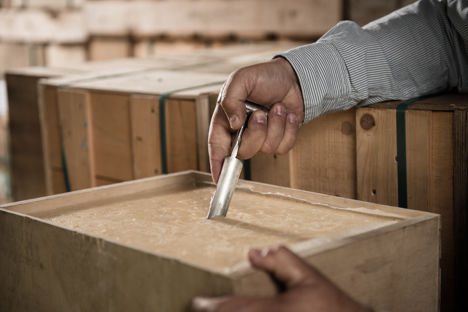
First grade: the story of cheddar
Nearly all of us have a block of cheddar in our fridge at all times, being gradually grated or sliced until it's time to buy another. But do you know how much effort and expertise it takes to make the UK's favourite cheese? We talked to a master grader to find out.
First grade: the story of cheddar
Nearly all of us have a block of cheddar in our fridge at all times, being gradually grated or sliced until it's time to buy another. But do you know how much effort and expertise it takes to make the UK's favourite cheese? We talked to a master grader to find out.
On average, people in the UK eat about thirty grams of cheese a day, and it’s highly likely that most of that cheese is cheddar – our favourite variety by far. Whether it’s a wedge of something special for a dinner party cheeseboard or a block for grating over dishes and stirring into creamy sauces, it’s a staple in most kitchens. But just because it’s readily available doesn’t mean it’s easy to produce; even after the cheese is made, it must be left to age for at least a few months (and for vintage varieties, several years) before it’s ready to eat. During this time, expert cheese graders vigorously check the cheddar over and over again to make sure it’s at its very best.
Richard Clothier, the managing director of Wyke Farms and a third-generation cheesemaker, knows everything there is to know about cheddar. His family owns four farms, all of which supply the milk for the company’s cheese, along with 100 other farms found within thirty miles of the dairy. ‘All our farmers adhere to Red Tractor standards,’ explains Richard. ‘We respect the land, the animals and the environment. The natural way is the only way to make great cheddar; if you look after nature, then nature will look after you.’
The best quality milk is paramount when making cheddar, but because cows eat different food throughout the seasons, it can be hard to keep things consistent. It takes ten litres of milk to make just one kilogram of cheese, so it’s important to use the very best you can find as the flavours are amplified tenfold. ‘Once we start ageing our cheeses, the milk’s subtle taste is magnified further,’ explains Richard. ‘The ‘black art’ of cheesemaking is being able to control the quality of the milk.
‘Milk changes throughout the year, but the good cheesemaker adapts,’ he continues. ‘Only an expert grader should be able to tell a spring cheese from a winter one. Our predecessors always said that any idiot can make a great cheese in April, May and early summer, but it takes a real professional to make good cheese in December and January when the milk is thinner and the cows are on the back end of the winter feed.’
How it's made
Once the milk is collected, it’s time to turn it into cheese. Richard follows his grandmother Ivy’s recipe, which is 150 years old. ‘We are one of the only dairies still using traditional bulk starters to culture our cheddar-making bacteria,’ says Richard. ‘It takes us longer to develop this than it does to actually make the cheese, but they’re the reason we get a rounded, complex flavour that you rarely see in other vintage cheddars.’
After the cheese has been separated into curds and whey by the starter culture, it undergoes the ‘cheddaring’ process – a technique that requires cutting and stacking the curds to remove moisture. It is then salted, pressed into moulds and left to mature in flavour. ‘Our cheddar is still aged in wooden maturing boxes which are constantly monitored by our master cheese graders,’ explains Richard. ‘Traditionally it was aged in an old stone barn, which kept a constant cool temperature, but we now recreate the same environment in much larger stores.’
It’s during this maturation time that Richard’s years of experience come into play. As the cheddar develops, he regularly uses a ‘cheese iron’ to test the smell, flavour and texture. ‘Cheddar grading involves taking a ‘core’ out of the cheese and instantly noting the aromas,’ he says. ‘We then look at the curd texture and feel it to check the ‘body’ of the cheese, by breaking a piece off and rubbing it in our fingers. This helps us work out how the curd breaks down and how that will happen as nature takes its course.’
Despite grading cheddar since he was just six years old, Richard believes a cheese grader is always learning. Cheese changes with seasonal milk and weather, so even if you have graded cheddar for ten years, you will only have seen ten cycles. ‘My dad has seen sixty-eight cycles as he started grading cheddar from a very young age,’ says Richard, ‘so he is the expert and is able to pass that experience on to me, like his father and mother did for him.’
It’s clear then, that whether you like the tang of a vintage that’s been aged for years or prefer the mild, buttery flavour of a younger variety, there’s still an awful lot of time, hard work and expertise that goes into making cheddar – something worth remembering the next time you’re eagerly grating it over pasta or slicing it up for a speedy sandwich.


